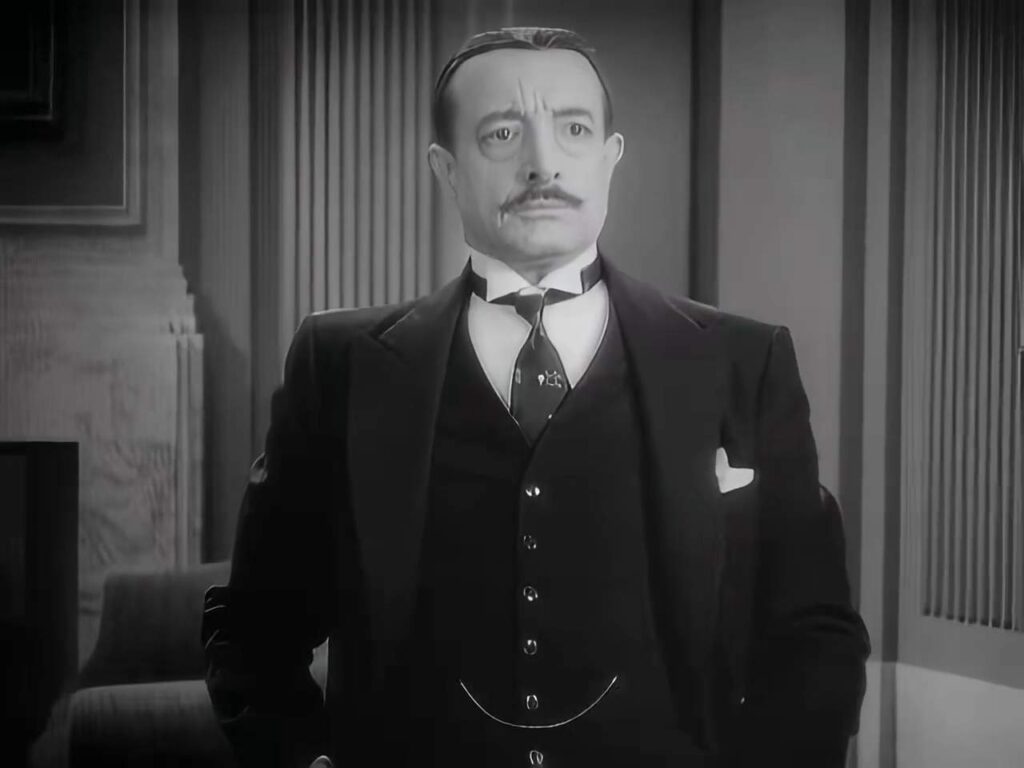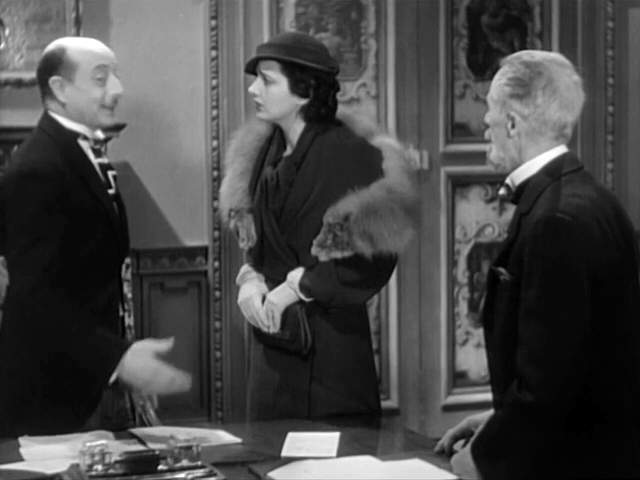Information
Full name: André Louis Ernest Alexandre Duval
Birth: August 24, 1880 in Saint-Germain-en-Laye, France
Death: January 26, 1952 in San Francisco, California
Marriages:
Charleen Eleanor Lippincott (1931 – ?)
Job on Snow White:
Voice of the Huntsman and Grumpy in the first French version (uncredited)

The son of the King of “Bouillons Duval”
André Louis Ernest Alexandre Duval was born in Saint-Germain-en-Laye on August 24, 1880 to Alexandre Duval and Marie Chéron. On November 20, 1929, Comœdia reads: “André Cheron, who is none other than the son of the famous Alexandre Duval”. So Alexandre Duval was famous. The same Comœdia of October 19, 1934, explains that this was the restaurateur, creator of the “Bouillons Duval”, who had once run a flourishing business and made a name for himself with his love of theater and demi-mondaines (prostitutes). It was for the love of one of them, Cora Pearl, that he attempted suicide at his mistress’s home, causing quite a scandal in the newspapers. In 1886, we learned the cause of André’s baldness: it was hereditary, and his father won a lawsuit against Mme Laffitte, a charlatan who had promised him hair regrowth in exchange for a 1,800-franc treatment. But this was not André’s only inheritance: it seems that Alexandre passed on to him a passion for acting. The gazettes regularly commented on his famous half-high hats and colorful outfits worn during dress rehearsals for high-profile plays. In 1911, he even began composing for an operetta, “Barmaid”, with librettist Michel Carré.
Legal Troubles
It seems to have been shortly after his father’s death from peritonitis in 1922, at the age of 76, that André left France. Circumstances seemed set for a complicated succession. Léon-Paul Fargue wrote an article about the former Dandy in Paris Soir in 1937, attributing two sons to him: “one went to make his fortune in Chile and disappeared into the darkness.” According to him, the other was a non-commissioned officer in the chasseurs d’Afrique and, following a quarrel with his father over money, published a private letter in the press with the aim of discrediting his worldly father. The newspaper of February 16, 1922, seems clearer: “He leaves from a first marriage a daughter married in Mozambique and only one son; the other was killed in the war. From his second wife, Madame Alexandre Duval, considerably younger than himself, he also leaves two children.
Presumably, as the only son from his first marriage and faced with a young widow with two offspring of her own, André was not necessarily attached to staying put, especially if there were already money quarrels with his father even before his death, who had tried in vain to interest him in the cooking business before the war. When he died, what little interest he still had in the restaurants was liquidated, and no Duval had anything more to do with the business.



The Great Escape
However, it was probably another problem that drove him out of the country: Le Radical of December 5, 1923 reports that he was sentenced “twice to two years’ imprisonment, and four times to six months’ imprisonment by the criminal court” for the theft of a sable coat from Révillon Frères worth 145,000 francs, breach of trust, and issuing bad checks. Judged “in absentia”, it seems that the swindler was not present at his trial. As his state of health was deemed worrying, he was allowed to go into a nursing home. In October, the examining magistrate noticed that he had disappeared from the aforementioned home, and issued a warrant for his arrest.
The reason: on September 29, 1923, at the age of 42, he had already traveled from Honolulu to Seattle. At the time, he was single, not an American citizen and had no intention of becoming one, but declared that he wished to remain in the United States. His declared next of kin would be his sister, Mrs. M. Albert Macekesay in South Africa. This was his first visit to the country from which he would never leave again. He arrived on October 15, 1923, and claimed to speak French, Spanish and German. He never returned to France.
Hollywood
André soon began appearing in Hollywood films. Probably after a period of work as an extra, André began to shoot roles large enough to be credited. The first documented role came in 1925, in a film with young leading man Richard Talmadge, then an international star known in France as Diavolo, whose fame had been built on a formula as a young athlete going through adventures in numerous feature films. Here, in The Fighting Demon, the hero finds himself in South America, a setting for which Frenchman André Cheron (for he has since adopted his mother’s name) seems to have been deemed exotic enough to play one of the bandits named Slippery Logan. Interestingly, in a silent art form at the time, the 40-year-old could have been used more often in American roles. But it seems that the casting directors didn’t often manage to ignore André’s foreign background.
In just over a dozen silent productions, the majority of his roles are French or at least foreign. But he invariably rubbed shoulders with the biggest stars of the day. A cabaret patron in The Girl From Montmartre with Barbara La Marr, a man in the audience at the Paris Opera with Greta Garbo in Torrent, a maître d’ for Norma Talmadge and Ronald Colman in Kiki, a Parisian waiter for Rod La Rocque in Gigolo, Virginia Valli’s French father in Evening Clothes, and so on.
The only time he was allowed to play a Broadway critic was in The Marriage Clause, directed by Lois Weber, and a few other less typical roles.
The famous directors who directed him at the time were also numerous: Cecil B. DeMille cast him as a wealthy merchant in The King of Kings, and he played for Murnau in 4 Devils, now lost.
The 1930 census confirms that he had emigrated in 1923 and was single at 49. At the time, he was renting an apartment for $70 a month. He gives his name as Chéron and he works.




The Talking Picture
With Street Girl, he inaugurated a series of small, more or less remarkable roles in talking pictures, and given his strong accent, they were all “ethnic”. In The Love Parade, he played a cuckolded husband opposite one of the most famous French lovers in America at the time: Maurice Chevalier.
This first talking picture directed by Ernst Lubitsch inaugurated a technique that would make French expatriate actors in the U.S. like André Cheron particularly popular with studios for several years: French sequences (in this case, the songs) were shot so that an adapted version could be distributed in French-speaking countries. Before long, entire productions were being remade in other languages, with bilingual actors or a new cast, all in the same settings as the original film.
It was then that André Cheron took a break from his roles as a French waiter and put his knowledge of the French language to good use, playing more prominent roles in French versions of American films shot in Hollywood.
In the color film King of Jazz, he played the emcee in the French version, while Bela Lugosi did the same in the Hungarian version. He also shares the screen with Otis Harlan, the American voice of Happy.
He also appeared in Boudoir diplomatique, Lopez le bandit, L’aviateur, Garde la Bombe, L’énigmatique Monsieur Parkes, Le bluffeur, Une heure près de toi, Caravane, Folies bergère and La veuve joyeuse. When the role allowed, he even played in English and Spanish versions (El impostor, Oriente es Occidente).
It was also during this period that, at the age of 50, he married 21-year-old Charleen Eleanor Lippincott, daughter of Milton F. Webster and A. Hawatt.
The multi-version craze was short-lived, however, and he soon returned to roles as a croupier, waiter or Frenchman in English-language productions that wanted to indulge in French exoticism without leaving Culver City. The January 1932 issue of “L’image” magazine reported a cruel anecdote according to which Constance Bennett refused to sit next to André Chéron at a party organized by André Luguet, on the pretext that Chéron would only earn $100 a week. True or false, the story didn’t prevent the two from sharing the screen three times after that, but it’s certainly indicative of the actor’s social class at the time.
Without ever landing a major role, he continued his career until 1941, when his last film, Louisiana Purchase with Bob Hope, was released on Christmas Day.
On June 3, 1946, he claimed his retirement pension.
He died in San Francisco on January 26, 1952. It’s amusing to note that in the French press, critics regularly remark – sometimes without even mentioning his artist’s name, probably adopted in part to make us forget his criminal past – that for the space of a scene we can catch a glimpse of “the son of the late King of the Bouillons”, whose life inspired Yves Mirande’s 1929 play “La grande vie”.
Snow White
When he worked on Snow White, he was at the end of his career. In Artists and Model Abroad, shot in 1938 at the same time as the French version of Snow White, he played the husband of Adrienne d’Ambricourt, the voice of the Queen. One of his most memorable roles, albeit silent and in a short film, is that of the scientist Becquerel in the film Romance of Radium, directed by Jacques Tourneur, husband of the voice of Snow White, Christiane Tourneur.
André Cheron has the distinction of playing two roles, thanks to the presence of his deep voice, which he modulates slightly to play the menacing huntsman and the dwarf Grumpy.














